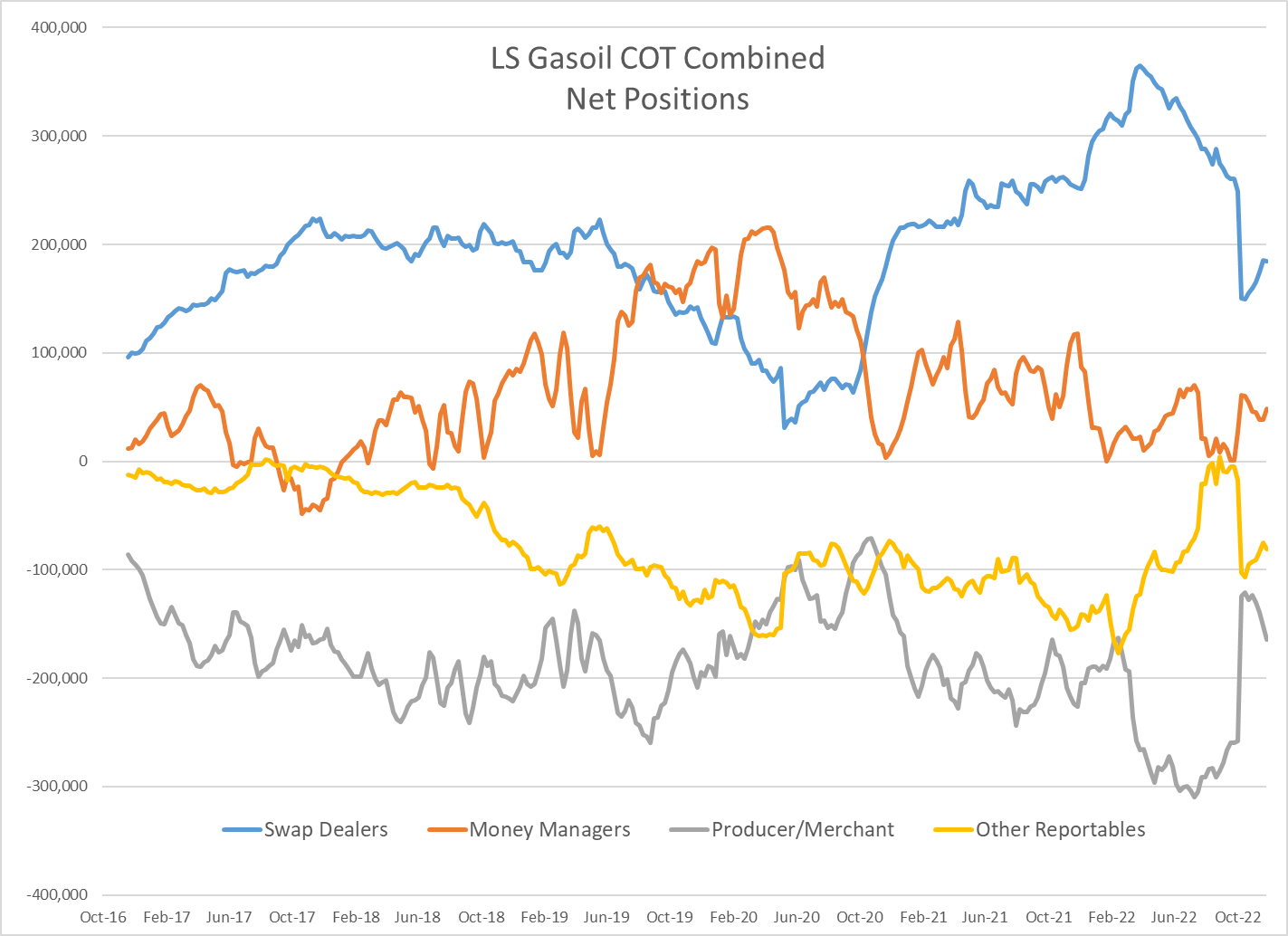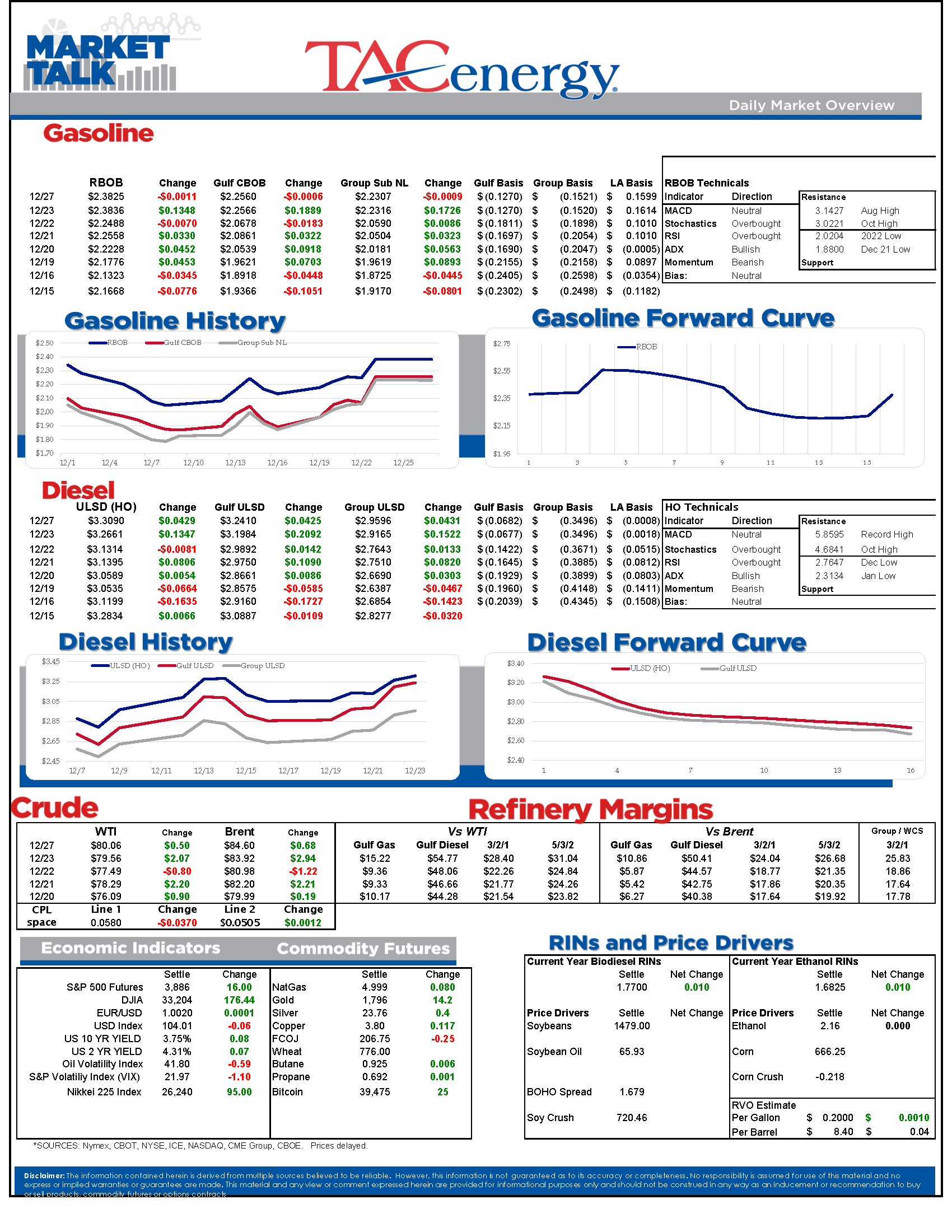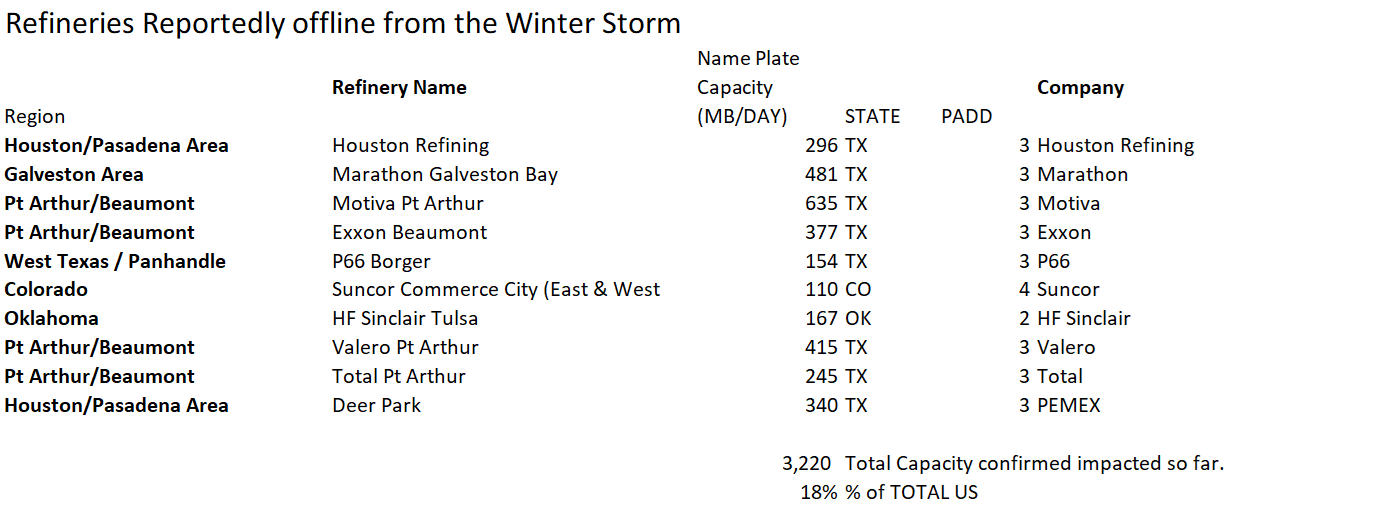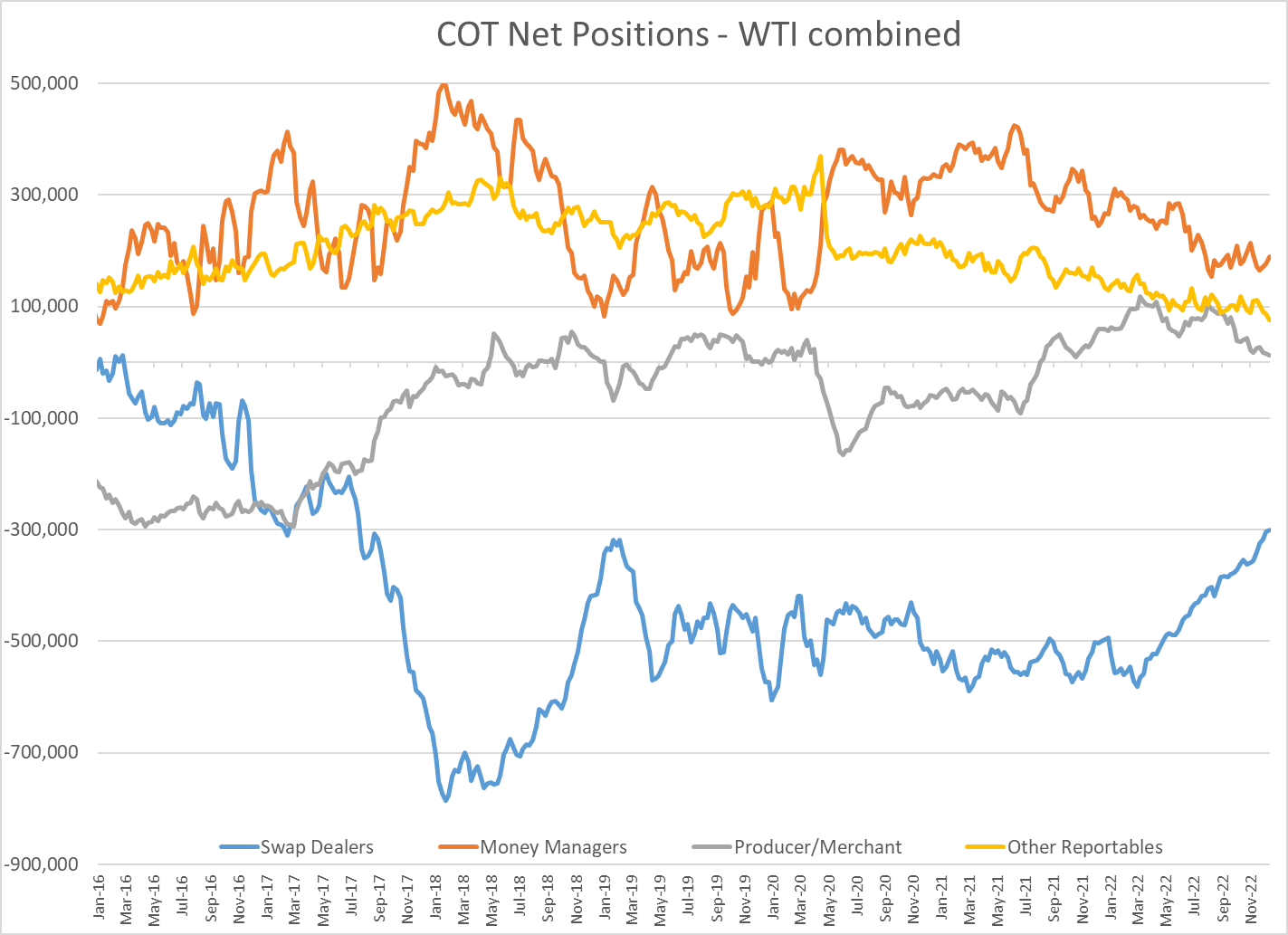Energy Futures Had A Big Rally On Friday

Energy futures had a big rally on Friday, and are following through with higher prices to start the short week as a pair of major supply disruptions, one actual and another potential, grip the market. ULSD continues to lead the move higher and came within striking distance of setting a new high for December overnight, marking a rally of more than 60 cents/gallon since bottoming out 2.5 weeks ago.
Russia threatened to cut its oil output in retaliation for sanctions on Friday, which sounds scary but may actually have to do more with limited options to sell and transport some of the nation’s production than a strategic plan to strike back at nations participating in the embargo.
Numerous refineries were knocked offline by the winter storm last week, including several of the largest in the country. Refineries accounting for approximately 18% of total US capacity had units reported offline over the weekend, although the total number of facilities impacted is likely to be much higher, which could place this event in the top 5 all time for disruptions. The steady stream of reports of refineries dropping had basis values for gasoline and distillates rallying in addition to the strong move higher in futures on Friday as the big physical shippers were scrambling to find replacement barrels.
Much warmer temps are sweeping the country allowing damage to be assessed and restarts to begin. While there’s never a good time for a mass refinery disruption, the week between Christmas and New Years typically has the weakest demand of the year, so may limit the impact of these shutdowns on the market. The timing is also likely to encourage some of those facilities to move up maintenance to take advantage of units already being offline and demand being weak. Oil and natural gas output was also hit by the huge storm, but it appears that the electric grids held up well in most cases, unlike what we experienced in early 2021.
The disruptions weren’t limited to production and refining facilities. Numerous terminals and pipelines across the country were reporting various issues, and vessel traffic in and around the NY Harbor was temporarily halted as the storm passed. Here too the impacts may have been much worse if they hadn’t happened just after the pre-holiday rush and just before Christmas day, which marks the slowest day for terminal loadings of the entire year.
Money managers were jumping back on the energy bandwagon last week with large percentage increases in net length seen across the board. While the percentage increases are large, the starting positions were fairly small, so the actual number of contracts added was less impressive. New length and short covering were consistent for crude and products, while open interest continues to hover near 6 year lows.
Baker Hughes reported 2 more oil rigs and 1 more natural gas rig drilling in the US last week, after both counts had declined in the prior 2 weeks. Drilling activity in the US has stagnated over the past couple of months as lower prices and various supply chain and labor shortages continue to have producers acting conservatively.
Keystone pipeline received approval to restart its shuttered line on Friday, with flows to the Cushing OK hub expected to resume this week.
Click here to download a PDF of today's TACenergy Market Talk.
Latest Posts
Week 16 - US DOE Inventory Recap
Energy Markets Trading Quietly In The Red As Ethanol Prices Rally To Five-Month High
The Struggle For Renewable Producers Continues As A Rapid Influx Of Supply And Crashing Credit Prices Make Biodiesel
After Years Of Backwardation, Diesel Prices Have Slipped Into Contango Over The Past Week
Social Media
News & Views
View All
Week 16 - US DOE Inventory Recap

Energy Markets Trading Quietly In The Red As Ethanol Prices Rally To Five-Month High
Energy markets are trading quietly in the red to start Wednesday’s session after a healthy bounce Tuesday afternoon suggested the Israel-Iran-linked liquidation had finally run its course.
There are reports of more Ukrainian strikes on Russian energy assets overnight, but the sources are sketchy so far, and the market doesn’t seem to be reacting as if this is legitimate news.
Ethanol prices have rallied to a 5-month high this week as corn and other grain prices have rallied after the latest crop progress update highlighted risks to farmers this year, lower grain export expectations from Ukraine, and the approval of E15 blends this summer despite the fact it pollutes more. The rally in grain and renewables prices has also helped RIN values find a bid after it looked like they were about to test their 4-year lows last week.
The API reported small changes in refined product inventories last week, with gasoline stocks down about 600,000, while distillates were up 724,000. Crude oil inventories increased by 3.2 million barrels according to the industry-group estimates. The DOE’s weekly report is due out at its normal time this morning.
Total reported another upset at its Port Arthur refinery that’s been a frequent flier on the TCEQ alerts since the January deep freeze knocked it offline and damaged multiple operating units. This latest upset seems minor as the un-named unit impacted was returned to normal operations in under an hour. Gulf Coast basis markets have shrugged off most reports of refinery upsets this year as the region remains well supplied, and it’s unlikely we’ll see any impact from this news.
California conversely reacted in a big way to reports of an upset at Chevron’s El Segundo refinery outside of LA, with CARBOB basis values jumping by more than a dime. Energy News Today continued to show its value by reporting the upset before the flaring notice was even reported to area regulators, proving once again it’s ahead of the curve on refinery-related events. Another industry news outlet meanwhile struggled just to remember where the country’s largest diesel seller is located.
Click here to download a PDF of today's TACenergy Market Talk

The Struggle For Renewable Producers Continues As A Rapid Influx Of Supply And Crashing Credit Prices Make Biodiesel
The sigh of relief selloff continues in energy markets Tuesday morning, with gasoline prices now down more than 20 cents in 7 sessions, while diesel prices have dropped 26 cents in the past 12. Crude oil prices are within a few pennies of reaching a 1 month low as a lack of headlines from the world’s hot spots allows some reflection into the state of the world’s spare capacity for both oil and refined products.
Gasoline prices are trading near a 6-week low this morning, but still need to fall about another nickel in order to break the weekly trendline that pushed prices steadily higher since December. If that trend breaks, it will be safer to say that we saw the end of the spring gasoline rally on April 12th for the 2nd year in a row. Last year RBOB futures peaked on April 12 at $2.8943 and bottomed out on May 4th at $2.2500. The high (at this point) for this year was set on April 12th at $2.8516, and the low overnight was $2.6454.
It’s not just energy commodities that are seeing an unwind of the “flight to safety” trade: Gold prices had their biggest selloff in 2 years Monday and continue to point lower today. Just how much money poured into commodities in the weeks leading up to the direct confrontation between Israel and Iran is unclear, but we have seen in year’s past that these unwind-events can create a snowball effect as traders can be forced to sell to cover their margin calls.
Supply > Demand: The EIA this morning highlighted the record setting demand for natural gas in the US last year, which was not nearly enough to offset the glut of supply that forced prices to a record low in February. A shortage of natural gas in Europe was a key driver of the chaotic markets that smashed just about every record in 2022, and an excess of natural gas supply in Europe and the US this year is acting as a buffer, particularly on diesel prices.
The struggle for renewable producers continues as a rapid influx of supply and crashing credit prices make Biodiesel, RD and SAF unprofitable for many. In addition to the plant closures announced in the past 6 months, Vertex Energy reported Monday it’s operating its Renewable Diesel facility in Mobile AL at just 50% of capacity in Q1. The truly scary part for many is that the $1/gallon Blender's tax credit ends this year and is being replaced by the “Clean” Fuel production credit that forces producers to prove their emissions reductions in order to qualify for an increased subsidy. It’s impossible to say at this point how much the net reduction will be for domestic producers, but importers will get nothing, and at current CI values, many biodiesel producers may see their “blend credit” cut by more than half.
Click here to download a PDF of today's TACenergy Market Talk.









